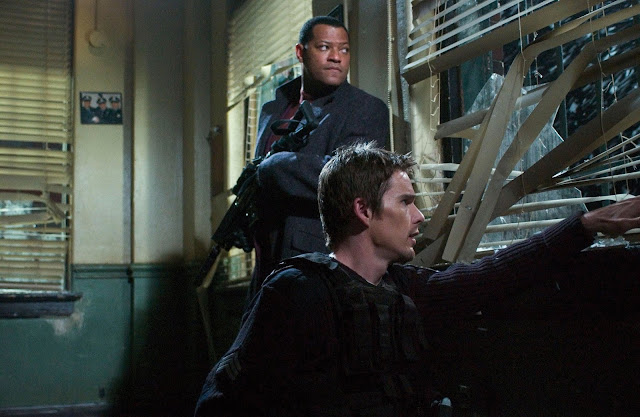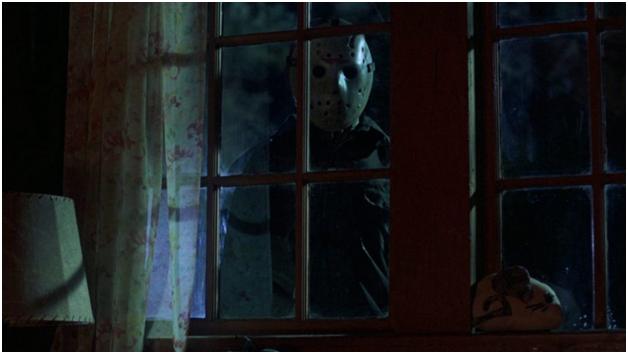Shitty Flicks is an ongoing column that celebrates the most hilariously incompetent, amusingly pedestrian, and mind-bogglingly stupid movies ever made by people with a bit of money, some prior porn-directing experience, and no clue whatsoever. It is here you will find unrestrained joy in movies meant to terrify and thrill, but instead poke at your funny bone with their weird, mutant camp-girl penis.
WARNING: I tend to give away major plot points and twist endings in my reviews because, whatever. Shut up.
Nicolas Cage's eyes bug wildly out of his head (his trademark expression) as he spins around, wielding his gun. He is surrounded by a group of angry women, intent on putting bees on his face, breaking his legs, and burning him alive inside the grundle of a large man made of wicker.
You bitches!" he screams as they fall on him, applying bees. "Oh my God, they're in my eye!"
The utter terror he is facing isn't the end. It's only the beginning. They lay his legs out over a large tree-trunk and smash his legs.
"Awww, my legs! My legs!" he screams, letting the audience know his legs are being broken. I want to look away but I can't. I am enthralled by this scene. "Killing me won't bring back your GOD DAMNED HONEY!" he suggests, trying to escape their wrath.
Ms. Summersisle, the queen bee of this pack, sports William Wallace-inspired make up as she replies, "but I know it will!"
Oh. Well then.
It's worth it for tasty honey.
The Wicker Man, just one of the many remakes of famous horror movies bombarding audiences, will go down in history as one of the most baffling films in ages. The film produces more questions than stomach pains caused by Hot Pockets.
What evil forces reside on Summersisle?
How many men have fallen victim to the womens' deceit?
Why does Nicolas Cage over-act in one scene, and then barely act in another?
What's with bee-beard girl?
Is this film supposed to be hilarious?
The questions are numerous. The laughs: even more so. The scares: missing in action.
Neil Labute once saw a horror movie on television: The Addams Family.
He was terrified.
He longed to make a film that scary.
He wrote and directed The Wicker Man, utilizing the same scare tactics. He crafted a film so horrifying, he himself has trouble watching it without squirming. I also find his film terrifying. But for different reasons.
The film begins...and Cage is delved into a question wrapped in a mystery wrapped in an enigma. He is also allergic to bees.
Uh-oh.
He goes to Bee Island anyway, at the behest of his runaway ex-fiancé, Willow, to help her find their missing daughter, Rowan. Upon arriving at the island, Cage meets a friendly group of oddball natives who stare at him as he talks, clearly perturbed by his presence. The group holds a wriggling sack that drips a rich amount of blood.
“What’s in the bag? A shark?” Cage asks stupidly, he, himself, unsure if he was even joking or not. The natives ignore him and question how he has made it to their beloved island of bad dialogue and bees. The sack wriggles once again and as Cage almost looks interested it, they dare him to look inside. He approaches the sack, and when it wriggles and shrieks, he decides that he doesn’t have to investigate the sack at all, even though he’s a cop. And then the natives laugh at him.
 |
Method acting led to Nicolas Cage trying to teach children
astronomy.
Right around after he taught them that space
was, "huge, bigger than
Detroit," he was dismissed by
his chaperon. |
Cage goes inside a cabin thing and asks for a drink from the bar maid. He receives said drink, but then instantly offends everyone by killing a bee.
“I’m allergic,” he reminds us, and then turns, holds his badge and tells everyone uninterestingly of the missing girl. The patrons, castrated men, stare at him with a look of bemusement. Cage gives up on trying to make an impact and begins his investigation.
He stops by a classroom to inquire about the missing girl. The teacher reacts to him with suspicion and annoyance. He demands to know her name, and when she responds with “Sister Rose,” he turns to the class and says “Rose, of course! Another plant!” as if the students would be amused and sympathetic to his plight.
All the children claim to not know the missing girl, as Cage walks around holding a picture. When Sister Rose claims she was not one of her students, Cage responds by checking the Teacher Book, which reveals the name of the missing girl.
Upon finding her name, he turns to the class of young girls and snarls, "You...little...liars." Then he turns to Sister Rose and states, "and you...you're the biggest liar of them all."
He begins to search the classroom, and upon doing so, releases a crow that was trapped by the students in an open-top desk. “What?” Cage barely manages as it flaps by his face, in the same manner you might say if I tapped you on the shoulder in a super market and told you, "elephant pie is made of chicken beats and my love for dead men."
Cage continues his investigation, which leads him down by the dock. He sits down and suffers through TWO nightmare sequences in a row, which he punctuates with an over-the-top and completely inappropriate “GOD DAMN IT."
 |
"I'm thinking PANCAKES this morning, my lovelies!"
|
Cage investigates and comes across an old burned doll that was hastily discarded next to some decrepit foundation. He turns to Willow, holds the doll to her and beckons to know: "HOW'D IT GET BURNED?? HOW'D IT GET BURNED HOW'D IT GET BURNED??"
Later, Cage runs across Sister Rose, riding her stupid bike down the path. She taunts him in her stupid bitchy banner, leading Cage to whip out his gun and demand that she “step away from the bike.” Upon relinquishing the bike, Cage takes it from her, and icily retorts: “Take your STUPID mask.”
Cage flips out and begins to storm each cabin, ripping masks off of all young girls, desperately trying to find his missing daughter.
The investigation leads to the inevitable conclusion that foul play was involved in the disappearance of the girl, and this leads to the best the second best scene in recent cinema history: Cage stares at a very mannish woman named Sister Beech, who relishes in his inability to solve the case of the missing child, and then: WHIPASH! Cage lets loose an admirable left jab to her square face, knocking her down for the count.
But the woman beating isn’t over yet.
Leelee Sobieski, also known as Helen Hunt’s better-chested clone, pops up to feign the idea she is capable of doing anything except feeding my desire for pale boobs, before receiving her own helping of Nicolas Cage: kicks, served cold. Cage’s ratatat karate chopping sends her flying back into the wall, shattering all manner of framed photos before depositing her dumpy ass on the hard ground.
 |
As a joke, Nicolas Cage had slipped some ecstasy
into Ellen Burstyn's tea
earlier that morning, but by mid-afternoon,
as the crew stood around,
burning daylight, no one was laughing. |
Cage shakes it off, picks up the beefy woman’s bear costume that she was to wear in the Summersisle Bullshit Parade and exits.
When Cage meets up with Willow during the parade, he amusingly lifts the mouth flap of the bear head and asks, “Why didn’t you wait for me?”
“I had to come,” she blandly retorts, shutting him up pretty easily.
The parade ends at what looks to be a pyre where - AAAAHHHHH!! - his daughter is lashed to a tree and is mere minutes from GETTING BURNED??? GETTING BURNED GETTING BURNED????
Cage, still in full bear regalia, storms this pyre, and in long shot form, applies a glorious right hook to her face, sending her sprawling down the hill.
Cage attempts to escape with Rowan, but alas, it’s no use. Once the paraders locate their location in the woods, Rowan runs to her mother, Willow, who it seems was in on it the whole time. Oh no, Willow. How could you?
Now, this is when things get interesting: depending on which version you are watching, you have the option to being treated to two magnificent endings:
ENDING # 1:
In the PG-13 cut, we see Cage laid out over a large leg-breaking beam, but we then fade to a montage of parade marchers making their way to the titular man of wicker as you hear audio of bones snapping and Cage screaming, "My legs! MY LEGS!"
ENDING # 2:
In the “unrated” cut, we see Cage again laid out over the large leg-breaking beam, only this time we experience the actual leg breaking, which is so ineptly done that it creates its own amusement. Once the leg smashing is complete, a modified and ancient-looking bird cage is placed over Cage’s face. Once it’s secured, a hatch on the top is opened and BEES are poured liberally in, as Cage bellows: “No, not the bees! Oh my God, they’re in my EYE!”
 |
"Oh, come now; we can surely fit one more.
Fish Man came all the way from New Zealand for this."
|
The bird cage is removed and we move onward to the finale: Cage is shoved in a wicker man and burned alive as he screams.
I eject the disc and I smile, knowing that no matter how bad life gets, that no matter how much bullshit will rear its head and get me down, I can take solace in the fact that Nicolas Cage will always be just an unsnapping DVD case away, on an island full of women, dressed as a bear, and punching like a Greek god.
Some films test the boundaries of human emotion. Some films haunt our inner psyche. Some films aren't about bees. The Wicker Man is none of these. The Wicker Man is something truly unique. The Wicker Man has to be seen to be believed.











































